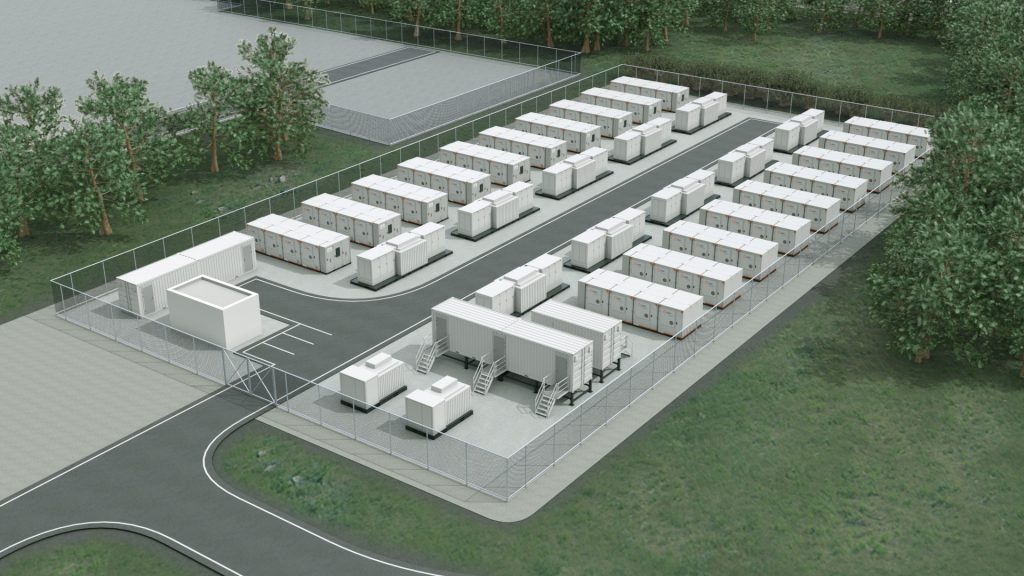EDF Renewables UK has signed a contract with global technology company Wärtsilä for a new transmission-connected battery storage facility in Sundon, Bedfordshire, which will form part of a new Energy Superhub in the region, helping to support the transition to a decarbonised electricity system and accelerate the UK’s net zero future.
The 50 MW/100 MWh lithium-ion battery storage facility in Sundon is capable of powering over 100,000 homes for two hours.[1] As the UK shifts towards a net zero power system, the battery will enable more renewable energy integration – storing energy when supply is abundant and discharging it when demand peaks – and increase the resilience of the electricity system. Construction is expected to start in Spring 2023.
The battery will connect to the transmission network at National Grid’s Sundon Substation, with EDF Renewables UK being one of three customers connecting to the substation as part of an innovative new grid park concept launched by National Grid to cost-effectively connect more renewables.
EDF Renewables UK will also develop a private wire network to support EV charging and the decarbonisation of transport. The private wire will share the battery connection to the transmission network, using it to deliver power to strategic locations in the local area, providing multi-megawatt capacity for ultra-rapid charging of electric vehicles (EVs), from cars to HGVs.
The project will form part of EDF Renewables UK’s nationwide rollout of Energy Superhubs, which will deliver up to 2 GW of transmission-connected battery storage and high-volume power connections. With transport and energy being the UK’s two most polluting sectors, EDF Renewables’ Energy Superhub model helps to cut emissions from both at the same time, scaling up renewable energy and clean transport to accelerate a net zero future.
Wärtsilä, the global technology company, has provided its propriety GridSolv Quantum system and GEMS Digital Energy Platform, in addition to the power conversion system and commissioning for the project. GEMS provides the data and insights to instruct trading parties and performance for comprehensive asset management. The energy storage technology will enable balancing services for the UK grid, including electricity market trading and frequency response, with the capability to support local consumers such as EV charging stations during grid outages.
EDF Renewables UK and Wärtsilä have worked closely together on several battery storage projects in the UK, including sites in Oxford, Birmingham, Coventry, and Kemsley in Kent.
To deliver on its 2035 net zero power pledge, the UK Government has set out plans to increase solar capacity to 70 GW and offshore wind capacity to 50 GW by the 2030s.[2] At present, the UK gets 39 per cent of its electricity from renewables,[3] but a smarter, more flexible system is needed to maximise the potential of this clean, homegrown energy source. National Grid forecasts suggest the UK could need up to 35 GW of electricity storage by 2050.[4]
Matthew Boulton, Director of Storage and Private Wire at EDF Renewables UK, said: “A renewable energy future is only made possible with a smart, flexible energy grid. That is why we are working with local councils to accelerate the rollout of Energy Superhubs, helping to unleash the potential of renewable energy and enable local people to reap the benefits of net zero through better access to zero carbon transport. We know the challenge ahead of us – we need more renewable energy and energy storage to back it up. Our battery storage facility in Sundon marks a key milestone for the UK as we lay the foundation for net zero.”
Jens Norrgård, Energy Business Director, Europe, at Wärtsilä Energy, said: “This contract strengthens EDF Renewables and Wärtsilä’s partnership and demonstrates our commitment to supporting the UK’s decarbonisation efforts. Net-zero power systems can unlock huge reductions in emissions and cost, and the UK is pioneering this transition with world-leading renewable energy targets. Wärtsilä’s energy storage technology is an important part of the mosaic of flexible capacity needed to balance renewable energy. Alongside our other projects, Sundon is delivering on our global ambition to create clean power systems.”
Notes to Editors
To arrange interviews and for other information, please contact:
Luke Webb luke.webb@greenhouse.agency +44 (0) 7527 313 503
Kiran Athwal kiran.athwal@greenhouse.agency +44 (0) 7891 122 579
About EDF Renewables
EDF Renewables UK and Ireland (www.edf-re.uk) is a subsidiary of EDF Group, one of the world’s largest low carbon electricity companies, and our investment and innovation is reducing costs for consumers and bringing significant benefits for communities. With our operating portfolio of 38 renewable energy sites including battery, onshore and offshore wind (together totalling more than 1 GW) we are providing much needed affordable, low carbon electricity. We have an expanding portfolio with almost 5 GW of projects in planning and development, including wind, battery and solar PV. We have 700 MW in construction.
About Wärtsilä Energy
Wärtsilä Energy leads the transition towards a 100% renewable energy future. We help our customers in decarbonisation by developing market-leading technologies. These cover future-fuel enabled balancing power plants, hybrid solutions, energy storage, and optimisation technology, including the GEMS energy management platform. Wärtsilä Energy’s lifecycle services are designed to increase efficiency, promote reliability, and guarantee operational performance. Our track record comprises 76 GW of power plant capacity and 110 energy storage systems delivered to 180 countries around the world.
[1] Assumes full 2 hour discharge of 50MW and average annual domestic consumption of 3772kWh.
[2] https://www.gov.uk/government/news/major-acceleration-of-homegrown-power-in-britains-plan-for-greater-energy-independence
[3]https://assets.publishing.service.gov.uk/government/uploads/system/uploads/attachment_data/file/1107502/Energy_Trends_September_2022.pdf
[4] https://www.nationalgrideso.com/document/173821/download

